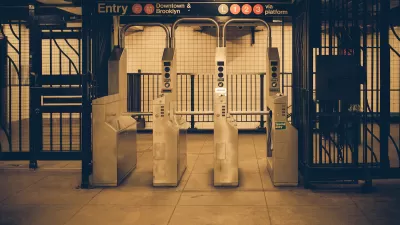It took an effort that was both well-planned and ad-hoc to save NYC's backbone from Hurricane Sandy, and have the city's transit system back up and running again soon after the storm. Robert Sullivan examines that effort and what happens next time.
"The subway is the Mississippi River of personal commerce in New York, for people who work in Midtown, Dumbo, Wall Street. For three days after Sandy hit, it was stopped dead, and for another two days after that, only part of it was running. The closure proved once again that New York does not function without its subway."
"When you look closely at it now, a year later, in the midst of another Atlantic hurricane season, you see all the ways in which the Metropolitan Transportation Authority and New York City Transit failed and triumphed," writes Sullivan. "And you see what it will take to keep the system going: technological improvements, yes, but also the oldest technology of all — the knowledge of the people who run the subway, many of whom have been there for their entire working lives."
"This year, should a Sandy-like storm show up, it won’t encounter a transportation system that has changed conspicuously," he adds. "But the thinking of the people running it has. As one senior official puts it, 'We definitely had tremendous lessons learned.'”
FULL STORY: Could New York City Subways Survive Another Hurricane?

Planetizen Federal Action Tracker
A weekly monitor of how Trump’s orders and actions are impacting planners and planning in America.

Restaurant Patios Were a Pandemic Win — Why Were They so Hard to Keep?
Social distancing requirements and changes in travel patterns prompted cities to pilot new uses for street and sidewalk space. Then it got complicated.

Map: Where Senate Republicans Want to Sell Your Public Lands
For public land advocates, the Senate Republicans’ proposal to sell millions of acres of public land in the West is “the biggest fight of their careers.”

Maui's Vacation Rental Debate Turns Ugly
Verbal attacks, misinformation campaigns and fistfights plague a high-stakes debate to convert thousands of vacation rentals into long-term housing.

San Francisco Suspends Traffic Calming Amidst Record Deaths
Citing “a challenging fiscal landscape,” the city will cease the program on the heels of 42 traffic deaths, including 24 pedestrians.

California Homeless Arrests, Citations Spike After Ruling
An investigation reveals that anti-homeless actions increased up to 500% after Grants Pass v. Johnson — even in cities claiming no policy change.
Urban Design for Planners 1: Software Tools
This six-course series explores essential urban design concepts using open source software and equips planners with the tools they need to participate fully in the urban design process.
Planning for Universal Design
Learn the tools for implementing Universal Design in planning regulations.
Heyer Gruel & Associates PA
JM Goldson LLC
Custer County Colorado
City of Camden Redevelopment Agency
City of Astoria
Transportation Research & Education Center (TREC) at Portland State University
Camden Redevelopment Agency
City of Claremont
Municipality of Princeton (NJ)




























